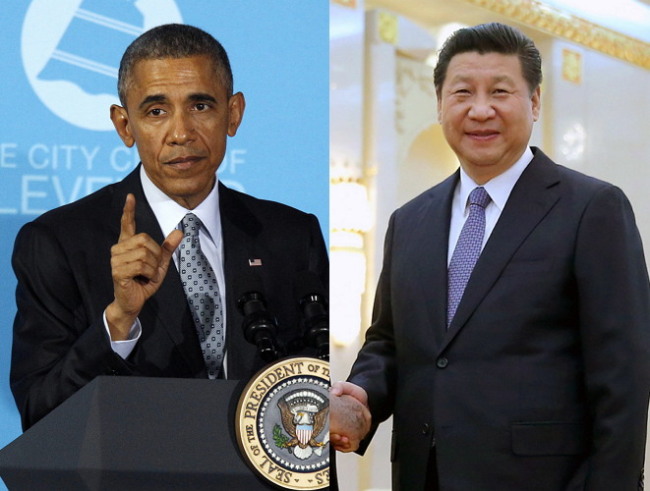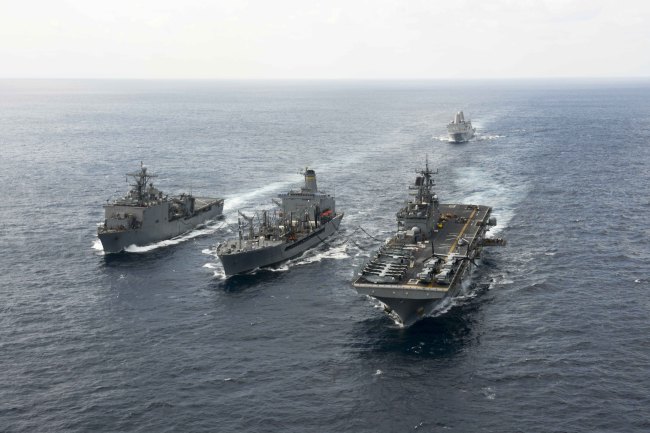The competition between the U.S. and China over regional primacy is growing as Beijing has been moving to apparently reshape the regional order on the back of its increasing economic and military prowess.
In recent years, the emergent power has sought to build and exert a stronger influence in political, security, financial and economic realms, and court neighboring states through various initiatives including a regional infrastructure investment bank.
Such moves have triggered tension with the U.S. that has strived to maintain the existing order through strengthening its network of alliances and regional partners, and developing military strategies to keep the ascendant power in check.
 |
U.S. President Barack Obama (EPA-Yonhap) and Chinese President Xi Jinping (AP-Yonhap) |
“For most of the past millennium, of course, China was the dominant country in the region ― the so-called ‘Sinosphere.’ It’s only in the past century and a half that its role has been so significantly reduced,” Rana Mitter, a China expert at the University of Oxford, said in a recent interview with The Korea Herald.
“China is keen to create a new regional order that will enable it to take the leading role in the region.”
Observers say that since Xi Jinping was sworn in as president in March 2013, Beijing has been seen as pursuing a national identity as a great power, given that it has sought a bigger say on global issues and become more aggressive in maritime disputes in the South and East China Seas.
“China used to identify itself as the world’s largest developing country. But the perception of its national identity seems to have changed into one as a developing major power,” said Kim Heung-kyu, international relations professor at Ajou University.
“China also used to regard itself as a land-based nation, but this perception too has changed into a nation encompassing both land and sea. It is now pursuing an identity as a central, hub nation on the Eurasian continent.”
Amid China’s pursuit of a reemergence on the global stage, the U.S. has been carefully watching Beijing’s diplomatic and political moves that could possibly challenge the rules, norms and institutions that Washington has fostered since the end of World War II. It has sought various diplomatic and security measures to maintain the status quo in Asia.
China seeking new order
The ongoing ruckus over the Asian Infrastructure Investment Bank has revealed one aspect of the Sino-U.S. rivalry. Analysts say that China has sought to establish the bank to revise the U.S.-led financial order. The U.S. has opposed the bank, citing a number of issues including transparency in the bank’s governance structure.
Despite Washington’s disapproval, more than 30 nations including Britain, France, Germany and all 10 members of the Association of Southeast Asian Nations have decided to join the AIIB, dealing a blow to the U.S. efforts to keep Western nations out of the ambitious institution.
Observers say that the AIIB, which is designed to finance infrastructure projects for underdeveloped countries in Asia, may rival the World Bank and Asia Development Bank that have been dominated by the U.S. and Japan.
“These proposals (the AIIB and other Chinese initiatives) suggest that China does want to challenge American leadership of key international institutions, but it has a long way to go before it is in a similar position of power,” said Stephen Walt, political scientist at Harvard University.
“If China does move in this direction, it will also have to be willing to take on other global responsibilities, and that is something Beijing has been reluctant to do so far.”
The AIIB has a capital target of $100 billion, and China will become the largest stakeholder with its contribution of $50 billion. The bank is expected to become operational by the end of this year. South Korea, a major ally of the U.S., has been under pressure from China to join it as a founding member.
The AIIB is not the only initiative that China has put forward in a move to emerge as a financial leader on the global stage.
Last year, the leaders of BRICS ― Brazil, Russia, India, China and South Africa ― agreed to establish a New Development Bank to be headquartered in Shanghai. They also agreed to create the $100 billion Contingency Reserve Arrangement.
Although the NDB will be run on an equal-share voting basis, China is expected to wield massive influence over the contingency reserve, given that its contribution will account for more than 40 percent of the total CRA capital.
The agreement to create the NDB and CRA are viewed by Western critics as China’s efforts to challenge the Bretton Woods institutions ― World Bank and International Monetary Fund ― to maintain the U.S.-led financial order.
China’s recent moves reflect the Asian power’s growing frustration over its limited voting rights in major global financial institutions. It has called for a greater say in the West-dominated institutions that befits its status of the world’s second largest economy. The AIIB could also be used as a tool to promote the yuan as a key global currency.
All the commotion about the AIIB has come amid China’s push for an ambitious project, called “One Belt One Road.” The project, which Xi Jinping unveiled during his visit to Kazakhstan in September 2013, seeks to connect China with Europe, Middle East, Central Asia and Southeast Asia through “land and maritime silk roads.”
The AIIB is expected to bankroll the massive connectivity project that consists of the “Silk Road Economic Belt” to link China’s landlocked neighbors and the “21st Century Maritime Silk Road” to connect the littoral states of the Indo-Pacific Oceans.
This is the reason why analysts call the AIIB a fundraising organ for China’s version of the “Marshall Plan” ― a U.S. initiative during the Cold War to support the postwar reconstruction of Europe, which helped America enhance its soft power ― one crucial element to become a great power.
The connectivity schemes have been promoted as initiatives to promote coprosperity, reduce development gaps and create new business opportunities for China’s neighbors. But observers have viewed the schemes with great suspicion, arguing that China could exploit them to secure its geopolitical interests and establish itself as a regional hegemon.
 |
Three U.S. naval ships engage in an amphibious integration training exercise in the East China Sea earlier this month. U.S. Navy (photo by Cameron McCulloch) |
Geopolitical tensions over China’s logistical projects have been exacerbated by Beijing’s seemingly aggressive stance on maritime sovereignty particularly in the South China Sea where it has engaged in disputes with Vietnam, the Philippines, Malaysia, Taiwan and Brunei.
Despite the competing claims over the Spratly Islands in the South China Sea, China has been turning numerous rocks and reefs in the archipelago into military bases equipped with naval harbors, airstrips, radar facilities and other equipment, reports said.
China has delineated its claim to the vast majority of the South China Sea with “the nine-dashed-line,” a maritime demarcation line that takes in more than 80 percent of the 3.5 million-square-kilometer South China Sea.
The sea boundary was first published on an official Chinese map in 1948 and has been included in other maps published after the communist state was launched in 1949, according to China’s claim. The critics, however, argue that the boundary was illegal and vague.
China’s moves to apparently establish a new order have also been seen in the security realm. Last May, at the Conference on Interaction and Confidence Building Measures in Asia, the Chinese leader called for a new Asian security cooperation architecture that would exclude any U.S. involvement. There, he indicated that bilateral military alliances in Asia were the “outdated thinking of the Cold War.”
On the economic front, China is pushing to establish the Regional Comprehensive Economic Partnership, a mooted free trade deal involving 16 nations including South Korea, China and Japan. But the U.S. has been leading the negotiations over the Trans-Pacific Partnership, from which China has virtually been excluded due to the high standards on labor, intellectual property, the environment and other sections.
U.S. struggles to maintain orderAmid China’s moves to apparently reshape the regional order, the U.S. has been deepening its diplomatic and military engagement in the Asia-Pacific with its much-publicized policy, called the “rebalance” toward the region.
Noting the looming shift in the dynamics of regional power due to China’s rise, the U.S. has been striving to strengthen its network of alliances and partner nations such as South Korea, Japan, Australia, Vietnam, Indonesia and the Philippines to boost bilateral or multilateral diplomatic and security cooperation.
One of the biggest concerns for the U.S. is the possibility that China could block what it calls the global commons ― the freedom of navigation and commerce at high sea, which is critical for all Pacific nations to ensure reliable supplies of energy and goods from the Middle East and elsewhere.
Thus, China’s aggressive claims to the islands and reefs in the South China Sea have driven the U.S. to strengthen military ties with the countries that have been embroiled in territorial disputes with China.
Last April, the U.S. and the Philippines signed the “Enhanced Defense Cooperation Agreement,” which gives the U.S. military greater access to military bases across the Philippines for a decade, and allows for the increased rotational presence of U.S. troops there.
The U.S. has also been upgrading its military ties with Vietnam as concerns have been rising in the Southeast Asian state over China’s maritime assertiveness. The U.S. has been conducting a series of military support programs for Vietnam including the provision of five patrol vessels.
With Australia, the U.S. has signed a 25-year deal to allow 2,500 U.S. marines and air force personnel to be deployed to the northern city of Darwin on a rotational basis.
Above all, the most crucial security partner for the U.S. in the Asia-Pacific is Japan given that the archipelago state has financial capabilities and military technologies, not to mention the strategic goal of keeping a rising China in check.
During Japanese Prime Minister Shinzo Abe’s visit to Washington, slated for late-April, the two allies are expected to sign a revision of its 1997 bilateral defense cooperation guidelines.
The revision is expected to contain a set of joint measures to cope with Chinese threats and other newly emerging scenarios. First adopted in 1978 to counter Soviet threats, the guidelines were last amended in 1997 to reflect post-Cold War security threats.
Amid China’s growing assertiveness in maritime disputes, the U.S. has also been developing a series of new military strategies and operational tactics.
Among them was the AirSea Battle concept that was designed to neutralize the adversaries’ capabilities to block the U.S.’ military’s access to operational areas near Chinese coasts, and to project power across the region.
The concept, however, has triggered a controversy due to its apparently hostile connotation and its focus on aerial and naval components that apparently spawned interservice tension and rivalries. In January, Washington dropped the controversial name and renamed it as the “Joint Concept for Access and Maneuver in the Global Commons.”
The new name apparently reflects the U.S. resolve to protect the global commons amid China’s continued claims over the vast majority of the South and East China Seas that contain the world’s major trade routes.
On the diplomatic front, the U.S. has increased its participation in a series of regional summit forums including the East Asia Summit and ASEAN Regional Forum where Washington has consistently called for a peaceful, diplomatic resolution of regional disputes.
By Song Sang-ho (
sshluck@heraldcorp.com)









